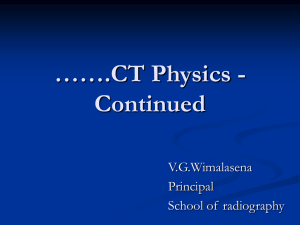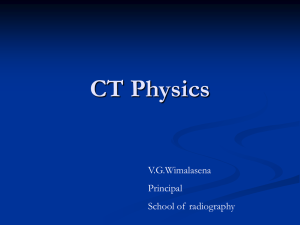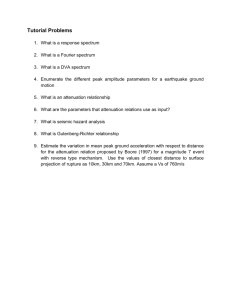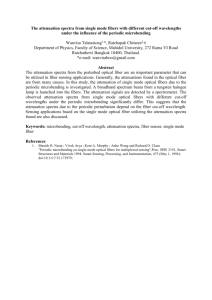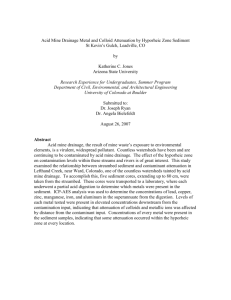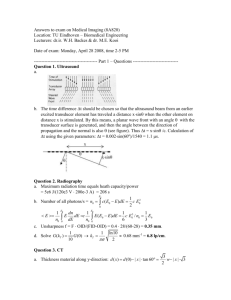SYMMETRICAL
advertisement
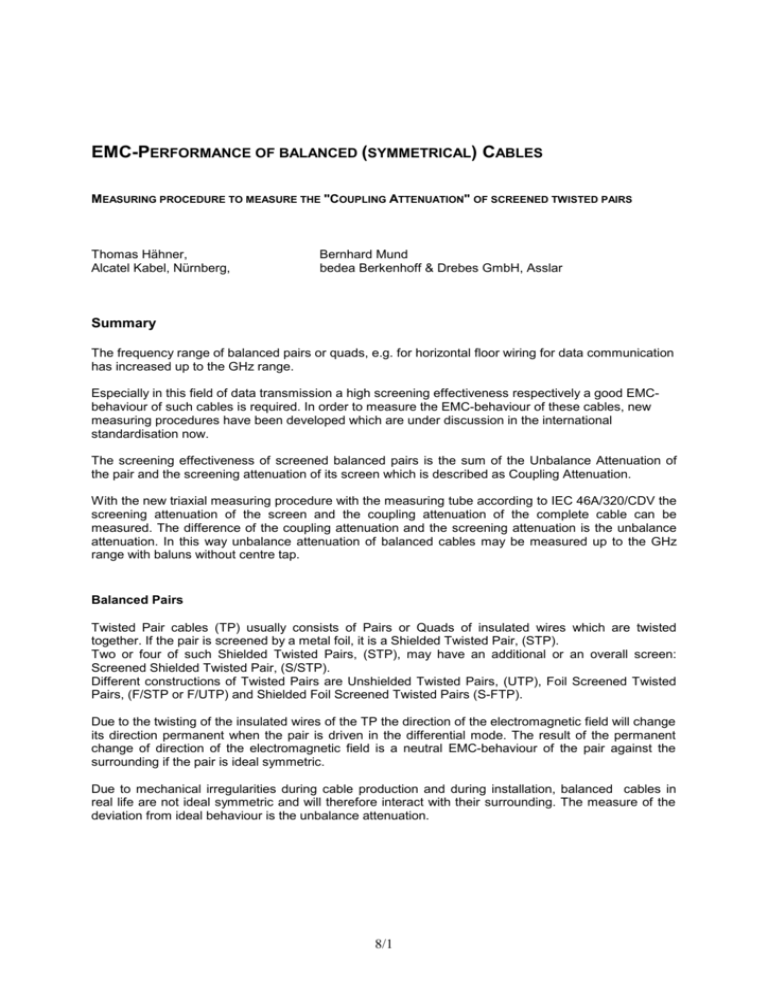
EMC-PERFORMANCE OF BALANCED (SYMMETRICAL) CABLES MEASURING PROCEDURE TO MEASURE THE "COUPLING ATTENUATION" OF SCREENED TWISTED PAIRS Thomas Hähner, Alcatel Kabel, Nürnberg, Bernhard Mund bedea Berkenhoff & Drebes GmbH, Asslar Summary The frequency range of balanced pairs or quads, e.g. for horizontal floor wiring for data communication has increased up to the GHz range. Especially in this field of data transmission a high screening effectiveness respectively a good EMCbehaviour of such cables is required. In order to measure the EMC-behaviour of these cables, new measuring procedures have been developed which are under discussion in the international standardisation now. The screening effectiveness of screened balanced pairs is the sum of the Unbalance Attenuation of the pair and the screening attenuation of its screen which is described as Coupling Attenuation. With the new triaxial measuring procedure with the measuring tube according to IEC 46A/320/CDV the screening attenuation of the screen and the coupling attenuation of the complete cable can be measured. The difference of the coupling attenuation and the screening attenuation is the unbalance attenuation. In this way unbalance attenuation of balanced cables may be measured up to the GHz range with baluns without centre tap. Balanced Pairs Twisted Pair cables (TP) usually consists of Pairs or Quads of insulated wires which are twisted together. If the pair is screened by a metal foil, it is a Shielded Twisted Pair, (STP). Two or four of such Shielded Twisted Pairs, (STP), may have an additional or an overall screen: Screened Shielded Twisted Pair, (S/STP). Different constructions of Twisted Pairs are Unshielded Twisted Pairs, (UTP), Foil Screened Twisted Pairs, (F/STP or F/UTP) and Shielded Foil Screened Twisted Pairs (S-FTP). Due to the twisting of the insulated wires of the TP the direction of the electromagnetic field will change its direction permanent when the pair is driven in the differential mode. The result of the permanent change of direction of the electromagnetic field is a neutral EMC-behaviour of the pair against the surrounding if the pair is ideal symmetric. Due to mechanical irregularities during cable production and during installation, balanced cables in real life are not ideal symmetric and will therefore interact with their surrounding. The measure of the deviation from ideal behaviour is the unbalance attenuation. 8/1 Unbalance Attenuation Screened balanced pairs may be operated in different modes: the differential mode (balanced) and the common mode (unbalanced). In the differential mode one conductor carries the current +I and the other conductor carries the current–I; the screen is without current. In the common mode both conductors of the pair carry half of the current +I/2; and the screen is the return path with the current – I, comparable to a coaxial cable. Under ideal conditions resp. with ideal cables both modes are independent from each other. Under real conditions, both modes influence each other. The "Unbalance Attenuation" of a screened pair is the logarithmic measure of the power which couples from one mode into the other mode, related to the feeding power . ZU UUn UUf ZU Figure 1: Common mode of a screened pair (STP) Differences in the diameter of the core insulation, different lay length, unequal twisting and different distances of the cores to the screen are some reasons for the unbalance of the pair. At low frequencies the unbalance attenuation is decreasing with increasing cable length. At higher frequencies and/or length the unbalance attenuation approaches asymptotic to a maximum value in the range of 20 dB to 40 dB, depending of the type of cable and its distribution of the inhomogenities over the cable length. Unbalance attenuation may be measured for the near end as well as for the far end of the cable. ZS USn USf ZS Figure 2: Differential mode of a screened pair (STP) Screening Attenuation As protection against electromagnetic disturbances respectively as protection against radiation cables have a screen of metallic foils and/or braids. Superscreened cables may have additional screens. The screening attenuation aS is the measure of the effectiveness of a cables screen. It is the logarithmic ratio of the feeding power P1 to the max. radiated power P2. a S 10 log P1 / P2 dB Details are given in IEC 61196-1 and prEN 50289-6C. 8/2 Coupling Attenuation As discussed above, balanced cables which are driven in the differential mode will radiate a part of the input power (or vice versa), due to irregularities in the cables symmetry. In the case of unscreened balanced cables (UTP) this radiation is depicted by the unbalance attenuation aU which describes in this case the complete EMC-behaviour of the cable. In the case of shielded balanced cables (STP), the radiated power from the pair (or vice versa) is additional screened by the outer screen. The measure of the effectiveness of this outer screen is the screening attenuation aS. Consequently the total effectiveness against electromagnetic disturbances of the shielded balanced cable (STP) is the sum of the unbalance attenuation aU of the pair and the screening effectiveness aS of the screen. Since both quantities usually are given in a logarithmic ratio, they simply may be added into the coupling attenuation aC. ac au a s dB ZWS USn USf ZWS UUn ZWU ZWU UUf Figure 3: Layout for near and far end unbalance Absorbing clamp method Based on the absorbing clamp method to measure the screening attenuation of coaxial cables according to IEC 61196-1 (DIN 47250 part 6) the European working group CENELEC TC46X/WG3 is preparing a procedure to measure the coupling attenuation of balanced cables (prEN 50289-6D). The cable under test is fed from a rf-generator via a balun. Due to the unbalance of the pair and the leakage of the screen surface currents will travel along the cables axis. This surface currents will be measured by the current transformer of one of the absorbing clamps. For the measurement of the screening attenuation aS respectively the coupling attenuation aC two clamps are required; where one clamp acts as absorber and the other clamp acts as absorber and as detector. With the current transformer of the clamp the maximum radiated power can be determined. The coupling attenuation is then obtained by the logarithmic ratio of the fed power P1 into the pair to the maximum radiated power P2. Figure four shows the principle measuring set up to measure the coupling attenuation with absorbing clamps. For the measurement at frequencies above 30 MHz, a measuring length of at least 6 m is required. Whereas screening attenuation is independent of the cable length, the magnitude of the unbalance attenuation depends on the cable length. To measure a certain unbalance attenuation of the pair, a length of about 100 m is required. This additional required cable length may be placed outside the measuring length on reels. 8/3 symmetrical/ asymmetrical termination absorbing clamp remaining cable length. approx.100 m cable under test generator Absorber (insertion loss > 10 dB) balun receiver Figure 4: Principle measuring set up with absorbing clamps Measuring tube Based on the procedure to measure the screening attenuation in the measuring tube (IEC 46A/320/CDV, prEN 50289C), an opportunity is given to measure the coupling attenuation aC in the measuring tube. The cable under test (CUT) is put in the tube and fed in the differential mode via a balun. The screen of the CUT is connected to the tube at the generators end. The opposite end of the cable is matched with a symmetrical/asymmetrical network which matches the common mode system as well as the differential mode system. The matching network and the connection to the screen is shielded by a screening case which forms the inner conductor of the outer system together with the screen under test. At the input of the receiver the coupling attenuation aS can be measured as logarithmic ratio of the Powers P1/P2 respectively of the voltages U1/U2. The operational loss of the measuring lead and the balun must be subtracted during the calibration procedure. As in the clamp method a length of about 100 m is required to measure a certain unbalance attenuation of the pair. When this cable length of about 100 m is arranged between the balun and the measuring tube on the feeding side of the CUT, the sensitivity of the set up is reduced by the operational loss of this additional length. To improve the sensitivity, in a further design of the set up, the required cable length of about 100 m is arranged at the receivers end of the tube. The tube at the receiver side now is open and the voltage of the second system is picked up by a feeding through connection. In this way, full sensitivity is given, only reduced by the operational loss of the balun and the measuring leads. The advantage in sensitivity of this method against the clamp method is the insertion loss of the clamp which is about 15 to 20 dB. 8/4 screen under test measuring tube generator symmetrical/ asymmetrical load receiver balun Figure 5: Set up to measure the coupling attenuation in the measuring tube. At the generator side, the screen of the cable under test is connected to the tube in the same way as in the standard tube procedure. The required cable length to measure a certain unbalance attenuation of about 100 m is arranged at the receiver side, outside the measuring tube. In this way, the sensitivity of the set up is no longer reduced by the composite loss of the additional length. The absorber at the receiver side of the tube acts as a high resistance matching load, parallel to the input resistor of the receiver as well as an absorber to avoid unwanted influences. Following advantages against the clamp method are given: Simple and easy calibration of the set up. screening against disturbances from outside. high dynamic range up to 120 dB without preamplifier. The procedure with the open tube is still under study and further measurements should be taken. receiver screen under test measuring tube generator absorber balun remaining cablelength approx. 100 m symmetrical/ asymmetrical termination Figure 6: Set up to measure the coupling attenuation in the modified measuring tube 8/5 Measuring of unbalance attenuation Figure 7 shows the measurement of the unbalance attenuation aU with baluns according to figure 3 and the screening attenuation aS as well as the coupling attenuation aC of a screened twisted pair (Twinax 105) measured with the tube. The curve "aC - max(aS)" is calculated as difference of the coupling attenuation aC and the max. value of the screening attenuation aS . The envelope of the resulting curve is nearly identical to the measured unbalance attenuation aU. (The slope down of the curves at frequencies > 250 MHz comes from nonlinearities of the baluns). By measuring of the screening attenuation of the screen and the coupling attenuation of the complete cable one can measure the unbalance attenuation of the pair up to high frequencies. 0.1 a/dB 100 200 300 f/MHz 0 aU -20 -40 aC-max(aS) aS -60 -80 aC -100 Roland Herrmann -120 aU: measured unbalance attenuation (far end) aS: measured screening attenuation (common mode) aC: measured coupling attenuation (differential mode) aC-max(aS): calculated unbalance attenuation Figure 7: Curves of unbalance, screening attenuation, coupling attenuation and calculated unbalance of a screened twisted pair (Twinax 105). Further investigations should be taken concerning the behaviour respectively the interpretation of measuring results of unscreened pairs (UTP). The measured coupling attenuation increases with increasing diameter of the measuring tube. Such measuring results, (opposite to the results of screened pairs), will give no information of the EMC-behaviour of the unscreened pair under installation, e.g. on a metallic cable tray. 8/6 Literature [1] Breitenbach, O./Hähner T.: Kabelschirmung im Übergang von MHz- zu GHz- Frequenzen. ntz Bd. 46(1993) H.8, S. 602-608 [2] Hähner, T: IEC TC46/WG5, Ivalo 16, Modified triaxial set-up, 05. 1997. [3] Halme, L./Szentkuti, B.: The background for electromagnetic screening measurements of cylindrical screens. Tech. Rep. PTT(1988) Nr. 3 [4] IEC 61196-1, Radio-frequency cables Part 1: Generic specification - General Definitions, requirements and test methods. [5] IEC 46A/320/CDV Shielded Screening Attenuation Test Method [6] Mund, B.: Messen der Schirmwirkung von Kabelschirmen, KM Verlag und Kongress, EMC-Kompendium 1997 S. 233 - 236 [7] Merz, C: Untersuchung an geschirmten symmetrischen Kabeln bei höheren Frequenzen. Diplomarbeit FH Gießen-Friedberg, Fa. bedea Berkenhoff und Drebes GmbH, Asslar [8] prEN 50289-6C, Generic specification for electrical test methods for cables used in analog and digital communication and control systems, Part 6C: Screening attenuation test method [9] prEN 50289-6D, Generic specification for electrical test methods for cables used in analog and digital communication and control systems, Part 6D: Coupling attenuation, absorbing clamp method 1998 The Institution of Electrical Engineers Printed and Published by the IEE, Savoy place, London WC2R OBL, UK. 8/7
